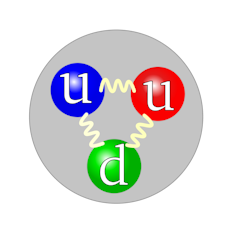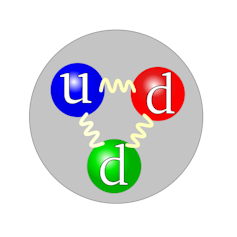One of humanity’s eternal questions surrounds what we are fundamentally made of. Many ancient philosophies believed in a set of classical elements: from water, air, fire and earth of ancient Greeks; to water, fire, earth, metal and wood of East Asian Wu-Xing thought.
Physicists today believe that matter is made up of twelve fundamental particles – quarks and leptons – that have no substructure and cannot be broken down into smaller particles. Quarks and leptons interact via four forces to make the universe we know today.
How these particles work to make matter
Six types of quarks have so far been experimentally confirmed, given the names of “up”, “down”, “strange”, “charm”, “bottom” and “top”, in ascending order of mass.
There also are six types of leptons, three electrically charged ones: “electron”, “muon” and “tauon”; and three electrically neutral ones called neutrinos. Each of the three neutrinos pair up with one of the charged leptons and are called “electron neutrino”, “muon neutrino” and “tau neutrino”, respectively.
These twelve elementary particles are mediated by exchanges of another type of particle referred to as a force mediator. Today, four types of elementary force mediators are known, namely the “gluon”, “photon”, “graviton” and “weak bosons”.
Actually, the graviton has not yet been experimentally confirmed, but many physicists assume that this mediator exists.

In an atomic nucleus, a proton is made up of two up quarks and one down quark, and a neutron is composed of one up quark and two down quarks. The force that binds three quarks in a proton or a neutron is called the strong force, and this force is due to exchanges of gluons.
An atomic nucleus constitutes an atom together with electrons orbiting around it. The relation between the nucleus and electrons resembles the one between the sun and planets in the solar system.

The nucleus and the electrons are attracted to each other, exchanging photons. The force between the nucleus and electrons is the electromagnetic force.
Many atoms constitute objects in our everyday life as well as much bigger components of the universe such as stars and galaxies. The force dominating this level of macroscopic phenomena is gravity, intermediated by gravitons.
In the center of stars, huge energy is generated by nuclear fusion being mediated by weak bosons. This energy makes the universe bright. In nuclear fusion, a down quark is changed to an up quark by the weak force. Stars are luminous because the fundamental building blocks are changing their types and providing energy.
Quarks like to hang in groups
Although most physicists believe that quarks are the fundamental building blocks which make up the universe, no one has observed an isolated quark on its own. This is due to the nature of the strong force.
Like a nucleus and an electron that attract each other due to their electrical charges, quarks are combined together by their color charges. The strong force is a force that works between color charges. Just like there are two types of electrical charges, there are three types of color charges – “red”, “blue” and “green” – analogous to the primary colors of light. The strong force forces quarks to be in a “white” state.
If you have learnt the theory of the elementary colors of light, you can remember that the superposition of the three elementary colors ends up with white. This is the reason why a proton and a neutron consist of three quarks. In a proton and a neutron, one quark has a red color, another has a blue color and the third one has a green color.
As a consequence of the fact that the strong force prohibits non-white states, no one has succeeded in isolating a quark. This phenomenon is called the quark confinement.
The existence of quarks has been established by a number of experiments, but should you find a way to isolate an individual quark, you would be in line for a Nobel Prize!
Cutting edge
Some physics theorists seriously think about the possibility that in the primordial universe (around 10-6 seconds after the Big Bang), another phase was realized in which quarks and gluons were flying as free particles. This phase is called the Quark-gluon plasma (QGP) phase.
So far, the RHIC has indicated that the creation of a QGP phase is possible at the hottest temperature ever reached in a laboratory (it is four trillion degrees Celsius, 250,000 times hotter than the center of the sun).
Though quarks are the elementary particles in physics today, there have been trials to see if there is structure within them. If one observes the structure of a quark, it means that quark is no longer elementary but a composite particle consisting of more fundamental particles.
One way to see the structure would be to follow the manner of Rutherford’s famous experiment performed 100 years ago. He shot alpha particles at a gold foil and observed that some of them were deflected at a very large angle showing the existence of a hardcore within an atom.
Likewise, an unexpected large deflection of incident particles in high-energy collisions might mean the discovery of the structure of quarks. The current most powerful particle accelerator is the LHC, which has been colliding protons at the center of mass energy of eight TeV (106 times higher than the energy of alpha particles).
The article was originally published on The Conversation and was authored by Takashi Kubota. Read the original article.



